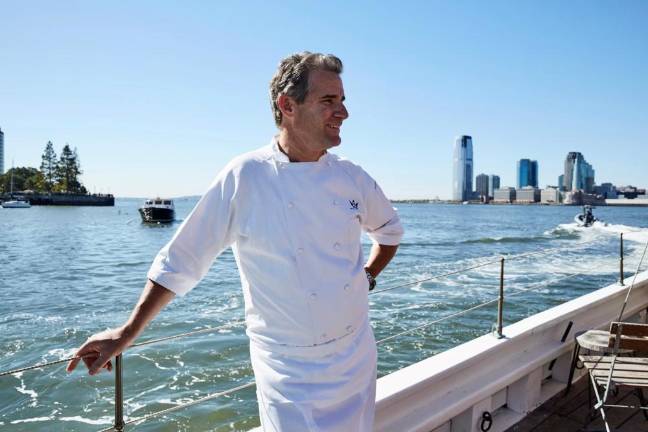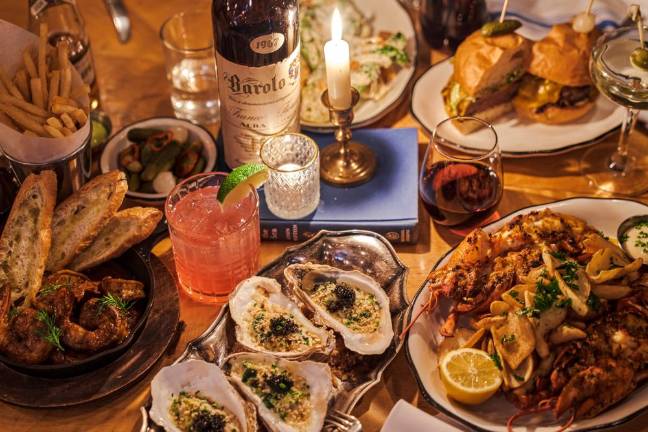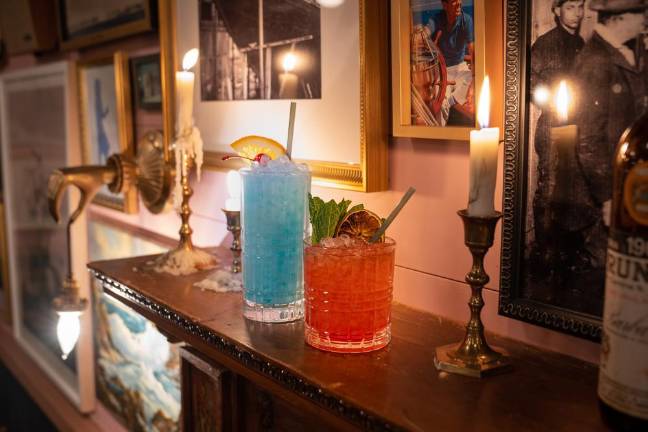At the Helm at Holywater
Celebrated chef Kerry Heffernan on his storied career and newest endeavor
Kerry Heffernan began his career in the Manhattan restaurant business while he was just 17 years old. He first entered the city’s culinary scene at a French landmark of old New York, Le Perigord Park on the Upper East Side, which he would commute to from his home in Connecticut. “I was working six days a week for $100 and I thought it was the greatest thing in the world,” he said.
The Culinary Institute of America alum, who graduated second in his class there, opened Eleven Madison Park as its executive chef with Danny Meyer in 1998. The Chelsea resident credits that role for introducing him to sustainable seafood at a time when it was not a hot-button issue. And when Meyer had the idea to create an eatery that served burgers and frozen custard, he asked him to help craft the perfect burger. Heffernan tasted “well over a hundred” to build the Shake Shack’s original burger, not realizing at the time that it would become the worldwide phenomenon it is today.
In 2014, he teamed up with brothers Alex and Miles Pincus to open Grand Banks, the highly buzzed-about oyster bar on a boat docked at Pier 25. After that, the duo launched more bars on the water, with Heffernan on board as their director of culinary and sustainable initiatives.
The “Top Chef Masters” finalist is at the helm in the kitchen of their fifth and first on-land venture, Holywater, which opened on May 11 on Reade Street in Tribeca. When asked about the atmosphere there, he said, “very New Orleans, seafood, Bayou, very, very casual, but there’s this charm and comfort around it.”
You were the opening chef at Eleven Madison Park. Tell us about that.
Eleven Madison was great. It was a different restaurant in those days. It was four times the number of seats that it currently has. Danny ran it as this American version of the most fun food you could have at the highest quality. So we did skate wing on the bone, terrine of beef shank with foie gras. We were doing every kind of organ meat in 1998 before everyone sort of got on that wave, really sort of challenging what people thought of as modern American food. Using local purveyors, talking about sustainability, all these things that were not even mentioned, nor should they be, this should be simply how you do business, but that was us in that day, going to the Union Square Greenmarket for daily inspiration.
The next most significant piece of that journey was me getting involved in sustainability and sustainable seafood and pursuing my love of the ocean and recreational fishing that turned into an understanding of the whole marine environment and conservation. So since then, I’ve really become a huge advocate for the oceans and sustainable seafood and that has changed a bit of the trajectory of how I look at things. And again, this is now kind of what everyone’s doing, which is great, but in those days it wasn’t necessarily the case.
You also helped to create the first menu for Shake Shack.
Danny had this idea about doing something like, it’s called Ted Drewes that he grew up with in St. Louis, and it’s this drive-in with frozen custard and burgers. And he wanted to make the greatest burger, but Danny being Danny, he wanted it to be accessible, he didn’t want to make some kind of $25 burger. So I spent weeks in Southern California and New York City researching the best burgers and coming up with something. So we landed on the Shake Shack and I guess it worked.
Did you ever think it would become so big?
Absolutely not. I did it as, “Let’s set this up as a one-time deal. I’ll consult and thank you very much.” And Danny was more than generous and fair at the time, but neither of us thought it would be something that would be worth investing in further. [Laughs]
I heard the burger at Holywater is really good. Did you take any inspiration from the one at Shake Shack?
I used what I learned. Obviously no one wants to repeat anything as a chef, so you’re using the tools that you developed to make that burger great, which sounds a bit silly, but it’s like, stop thinking about it and just start tasting it. All the descriptors and everything that everyone loves to use and attributes are great and they are accurate, but all that is all irrelevant if you’re just trying to make a burger that tastes good as opposed to one that is impressing people who read the menu online.
How did you meet Alex and Miles and how did your position at Grand Banks come about?
It was a friend of a friend who introduced us and they asked me if I knew anybody and I said, “Geez, that sounds really interesting, let me give that a crack.” And it’s been a consultancy since. Originally, I was involved every day at Grand Banks, but since they’ve grown, we have five and we’re opening another one or two more restaurants soon.
Tell us how you created the menu for Holywater. It’s inspired by New Orleans, right?
Very much so. So Alex and Miles are from New Orleans and we have a restaurant down there. We still maintain some creative control, but the day-to-day is really taken up by another team. I spent many weeks down there visiting crayfish farmers, fisheries, the shrimp guys, their snapper guys, all the produce. The meat is really more about the charcuterie and theirs is ... in the west of New Orleans, it’s real Cajun country and they still appreciate and go deep into some very elaborate preparations of charcuterie inspired by original French recipes, but then very much with a current Cajun flair.
We were also looking for sources of alternative sustainable seafood, so we ended up using a lot of sheepshead, which, at the time, and I’m only talking five years ago, was not something that anybody else wanted to use because it was like porgy that we use here in New York, considered bony and small and that was something that the less-elite diner, shall we say, would have catered towards. It wasn’t considered this noble family of red snapper, etcetera. So we really focused on that and created dishes around that. For this research, I was spending a lot of time in every restaurant we could get into. And everyone down there was great. New Orleans has such incredible resources when it comes to crab, shrimp, oysters, crayfish that they don’t really need to use things that challenge the sustainable model.
What are the bestselling items on the menu so far?
Certainly oysters, the barbecue shrimp is huge. The burger is big. The broiled lobster is a pretty good seller. The pralines, we have an original New Orleans praline recipe that we’re using. The crawfish etouffee, it’s with grits instead of rice, which is a bit of a change.
What are the best and worst parts of your job?
Best part is the ability to, this is gonna sound so trite, but making people happy while executing something that is beautiful, fun and that you believe in. I believe so much in this notion of sustainability and using products that fit that mold and that it makes people so happy and that my team can be so well motivated by doing that, that’s what makes me the happiest. The hardest part is honestly, getting people right now, so staffing is a big challenge. In the other restaurants, because they are all outdoors, it’s the weather. We have four other restaurants that are entirely weather dependent, so the hardest part is picking which forecast to follow.
Who has been a memorable person you’ve cooked for in your career?
The one who always comes to mind is Sidney Poitier, who passed away recently. And he was the most gracious gentleman. He was the picture of just charm and grace. He liked to have white rice and he asked me in the most kind and gentile way. And we didn’t have it ready at the moment, he waited. Then we would see his reservation in the books and so it would be no big deal for me to make a small pot of rice. And he was so appreciative of just a little bit of white rice and contrast that to the demanding, snooty, crazy people that can expect the world and all that. And he was just so gracious and kind. It’s an example of how you wish anyone was regardless of their status.


